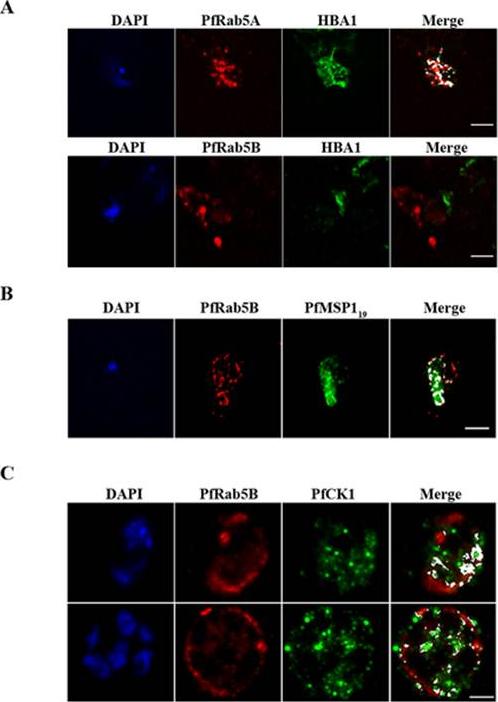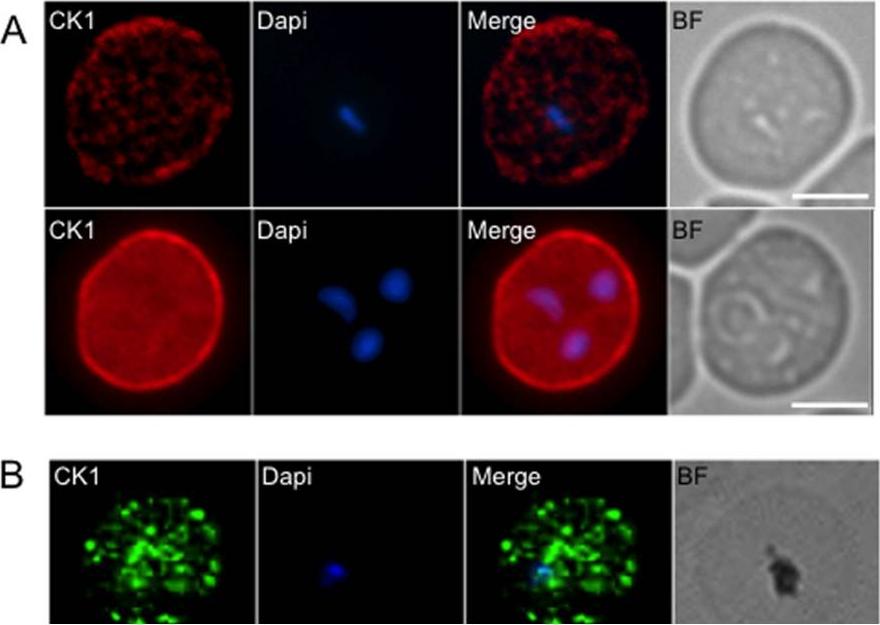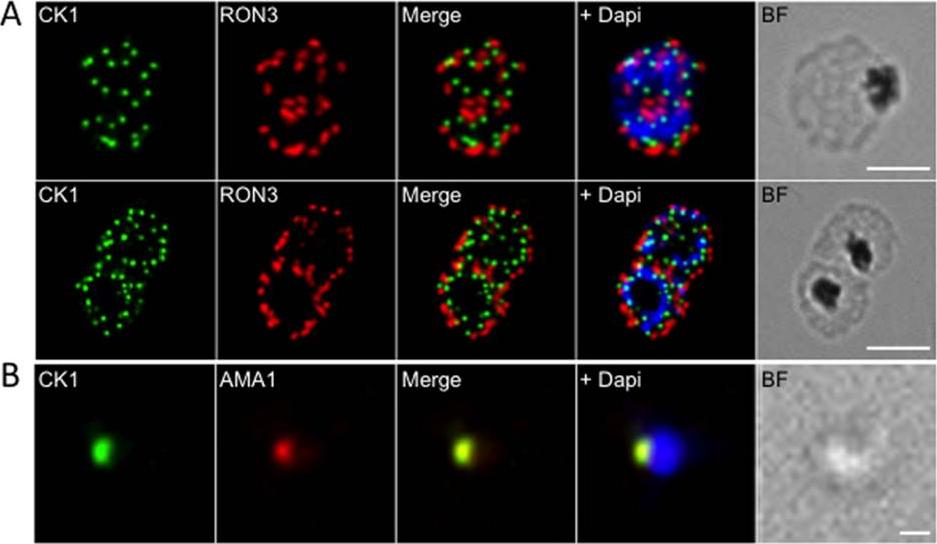PF3D7_1136500 casein kinase 1 (CK1)
Disruptability [+]
| Species | Disruptability | Reference | Submitter | |
|---|---|---|---|---|
| P. falciparum 3D7 |
Refractory |
22127061 | Theo Sanderson, Wellcome Trust Sanger Institute | |
| P. falciparum 3D7 |
Refractory |
USF piggyBac screen (Insert. mut.) | USF PiggyBac Screen | |
| P. berghei ANKA |
Refractory |
RMgm-552 | Imported from RMgmDB | |
| P. berghei ANKA |
Refractory |
RMgm-239 | Imported from RMgmDB | |
| P. berghei ANKA |
Refractory |
PlasmoGEM (Barseq) | PlasmoGEM | |
Mutant phenotypes [+]
None reported yet. Please press the '+' button above to add one.Imaging data (from Malaria Metabolic Pathways)

PfRab5B colocalises with PfMSP1 and PfCK1, but not with haemoglobin. (A) PfRab5A colocalises with haemoglobin (HBA1) containing vesicles unlike PfRab5B. (B) PfRab5B colocalises to differing degrees with the C-terminal 19 kDa fragment of PfMSP1 on structures close to the food vacuole and the parasite nucleus shown in blue by DAPI staining. (C) PfRab5B colocalises with PfCK1 on intracellular structures and at the parasite plasma membrane. Areas of colocalistaion are shown in white and used to calculate Pearson’s r coefficients. Scale bars, 2 mm.Ezougou CN, Ben-Rached F, Moss DK, Lin JW, Black S, Knuepfer E, Green JL, Khan SM, Mukhopadhyay A, Janse CJ, Coppens I, Yera H, Holder AA, Langsley G. Plasmodium falciparum Rab5B Is an N-Terminally Myristoylated Rab GTPase That Is Targeted to the Parasite's Plasma and Food Vacuole Membranes. PLoS One. 2014 9(2):e87695
See original on MMP
PfCK1 immunofluorescence assay on wild-type parasites and transgenic parasites expressing a GFP-tagged PfCK1. (A) 3D7 parasites were examined by immunofluorescence using an anti-PfCK1 serum labelled with rhodamine. DAPI was used to stain the nucleus and the scale bar represents 10 μm. A pre-immune serum used as a negative control did not yield any signal (not shown). (B) An erythrocyte culture infected with synchronised parasites expressing GFP-tagged PfCK1 from the endogenous locus was examined by immunofluorescence using an anti-GFP antibody. DAPI was used to stain the nucleus the scale bar represents 10 μm. As a negative control wild-type 3D7 parasites stained with the same anti-GFP antibody and did not yield any signal (not shown). A pool of CKI is exported to the host erythrocyte periphery at the early stage of infection, and subsequently detectable mostly within the parasite in late trophozoites and schizonts.Dorin-Semblat D, Demarta-Gatsi C, Hamelin R, Armand F, Carvalho TG, Moniatte M, Doerig C. Malaria Parasite-Infected Erythrocytes Secrete PfCK1, the Plasmodium Homologue of the Pleiotropic Protein Kinase Casein Kinase 1. PLoS One. 2015 10(12):e0139591.
See original on MMP
Localisation of PfCK1 in micronemes. (A) Localisation of PfCK1 and PfRON3 in schizonts and segmenters. DAPI was used to stain the nucleus and the scale bar represents 10μm. (B) Localisation of PfCK1 and AMA-1 in merozoites. DAPI was used to stain the nucleus and the scale bar represents 1μm. A punctate pattern emerges in segmenters, with one PfCK1 dot in each developing merozoite, adjacent to the rhoptry marker RON3. In line with this observation, PfCK1 colocalises with AMA-1, a protein of micronemes that is released at the very early stages of invasion.Dorin-Semblat D, Demarta-Gatsi C, Hamelin R, Armand F, Carvalho TG, Moniatte M, Doerig C. Malaria Parasite-Infected Erythrocytes Secrete PfCK1, the Plasmodium Homologue of the Pleiotropic Protein Kinase Casein Kinase 1. PLoS One. 2015 10(12):e0139591.
See original on MMPMore information
| PlasmoDB | PF3D7_1136500 |
| GeneDB | PF3D7_1136500 |
| Malaria Metabolic Pathways | Localisation images Pathways mapped to |
| Previous ID(s) | PF11_0377, PF3D7_1136500.1, PF3D7_1136500.2 |
| Orthologs | PBANKA_0912100 , PCHAS_0713400 , PKNH_0934700 , PVP01_0937400 , PVX_092440 , PY17X_0913600 |
| Google Scholar | Search for all mentions of this gene |